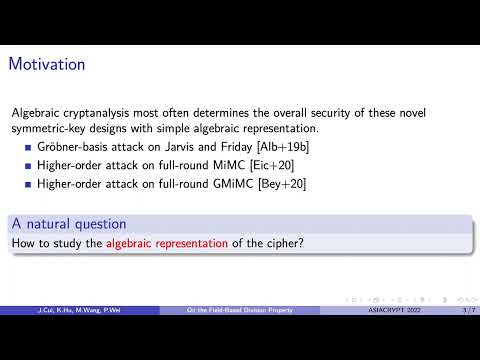CryptoDB
On the Field-Based Division Property: Applications to MiMC, Feistel MiMC and GMiMC
| Authors: |
|
|---|---|
| Download: | |
| Presentation: | Slides |
| Conference: | ASIACRYPT 2022 |
| Abstract: | Recent practical applications using advanced cryptographic protocols such as multi-party computation (MPC) and zero-knowledge proofs (ZKP) have prompted a range of novel symmetric primitives described over large finite fields, characterized as arithmetization-oriented (AO) ciphers. Such designs, aiming to minimize the number of multiplications over fields, have a high risk of being vulnerable to algebraic attacks, especially to the higher-order differential attack. Thus, it is significant to carefully evaluate the growth of the algebraic degree. However, degree estimation for AO ciphers has been a challenge for cryptanalysts due to the lack of general and accurate methods. In this paper, we extend the division property, a state-of-the-art frame- work for finding the upper bound of the algebraic degree over binary fields, to the scope of F2n, called general monomial prediction. It is a generic method to detect the algebraic degree for AO ciphers, even applicable to Feistel ciphers which have no better bounds than the trivial exponential one. In the general monomial prediction, our idea is to evaluate whether the polynomial representation of a block cipher contains some specific monomials. With a deep investigation of the arithmetical feature, we introduce the propagation rules of monomials for field-based operations, which can be efficiently modeled using the bit-vector theory of SMT. Then the new searching tool for degree estimation can be constructed due to the relationship between the algebraic degree and the exponents of monomials. We apply our new framework to some important AO ciphers, including Feistel MiMC, GMiMC, and MiMC. For Feistel MiMC, we show that the algebraic degree grows significantly slower than the native exponential bound. For the first time, we present a secret-key higher-order differential distinguisher for up to 124 rounds, much better than the 83-round distinguisher for Feistel MiMC permutation proposed at CRYPTO 2020. We also exhibit a full-round zero-sum distinguisher with a data complexity of 2^{251}. Our method can be further extended for the general Feistel structure with more branches and exhibit higher-order differential distinguishers against the practical instance of GMiMC for up to 50 rounds. For MiMC in SP-networks, our results correspond to the exact algebraic degree proved by Bouvier. We also point out that the number of rounds in MiMC specification is not necessary to guarantee the security against the higher-order differential attack for MiMC-like schemes with different exponents. The investigation of different exponents provides some guidance on the cipher design. |
Video from ASIACRYPT 2022
BibTeX
@inproceedings{asiacrypt-2022-32478,
title={On the Field-Based Division Property: Applications to MiMC, Feistel MiMC and GMiMC},
publisher={Springer-Verlag},
author={jiamin cui and kai hu and puwen wei and meiqin wang},
year=2022
}

